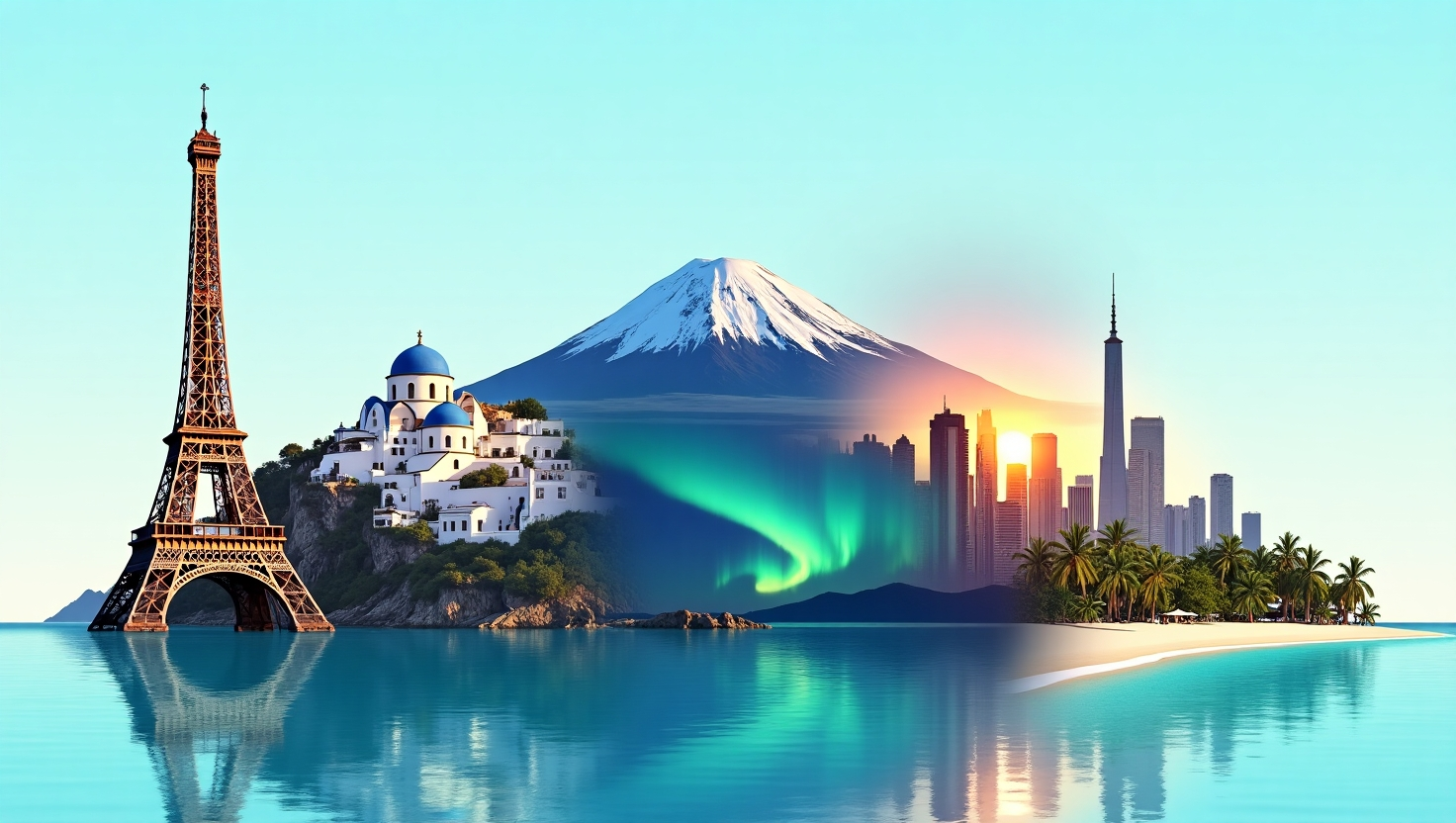Top 10 Travel Destinations in the World — Ultimate 2025 Bucket-List Guide
Dreaming of your next big trip? This guide curates the Top 10 travel destinations in the world for curious, experience-first travellers in 2025. Each pick is chosen for a unique mix of culture, nature, food and “memorable moments” — from sunrise over Kyoto’s temples to the volcanic landscapes of Iceland, from the ruins of Machu Picchu to the glamorous sunsets of Santorini. For every destination you’ll find what makes it special, the best months to visit, top things to do, a practical tip or two, and one realistic sample itinerary idea.
This is a travel-first list, not a ranking by visitor numbers: it’s for people who want beautiful places that reward planning. I checked official tourism pages and UNESCO listings for key facts, and I’ve kept advice practical and current—so you can decide faster and plan better. Pack your bag: we’ll cover iconic cities, remote natural wonders and a couple of off-the-beaten-track gems so your next trip becomes an actual story you’ll keep telling.
How to read this list
This isn’t a strict “best vs worst” leaderboard. Think of it as ten destinations that consistently deliver—across cultures and landscapes—memorable moments. For each place I give:
Why it belongs here (what you’ll remember),
Best time to go,
Top things to do, and
One practical travel tip.
Ready? Let’s go.
1. Paris, France — art, cafés and timeless city romance
Why go: Paris balances world-class museums, iconic landmarks and effortless street-life: think Louvre masterpieces, riverside strolls, late-night bistros and the Eiffel Tower’s sparkle. The city remains a top inspiration for art, fashion and slow-city pleasures.
Best time: April–June and September–October for mild weather and fewer crowds.
Top things to do:
Sunrise (or sunrise-adjacent) photos at Trocadéro for the Eiffel Tower.
Louvre (book ahead) and a late stroll along the Seine.
Montmartre for cafés and views; Le Marais for boutiques and food.
Tip: Buy museum and monument tickets in advance; stroll neighbourhoods at dusk for the best Paris vibe.
2. Kyoto, Japan — temples, seasons and traditional Japan
Why go: Kyoto is Japan’s cultural heart: centuries-old temples, manicured gardens and seasonal spectacles (cherry blossom in spring, maple leaves in autumn). Its UNESCO-listed ensemble of historic monuments cements Kyoto’s reputation as a must-see for culture lovers.
Best time: March–April (cherry blossoms) and October–November (autumn colors).
Top things to do:
Walk the Fushimi Inari torii path early morning.
Visit Kinkaku-ji (Golden Pavilion) and Kiyomizu-dera.
Explore Gion for teahouse architecture and, sometimes, glimpses of geisha culture.
Tip: Use public transit passes and plan temple visits early to avoid lines.
3. New York City, USA — the city that never pauses
Why go: Manhattan skylines, Broadway theatre, museums (MoMA, Met), and distinct neighbourhoods across five boroughs make NYC endlessly discoverable. It’s one of the few cities that feels different every time you return.
Best time: April–June and September–November for comfortable weather and events without summer crowds.
Top things to do:
Walk the High Line and explore Chelsea Market.
See a Broadway show and visit the Met or MoMA.
Explore Brooklyn neighbourhoods and the views from DUMBO.
Tip: Book popular shows and attraction entry windows ahead; use subway passes for fast, economical travel.
4. Rome, Italy — ancient stones and modern piazza life
Why go: Rome layers millennia of history with everyday la dolce vita: Colosseum ruins, Vatican treasures and piazzas where espresso, gelato and people-watching are equally sacred. It’s a compact city with huge cultural payoff.
Best time: April–June and September–October (avoid peak summer heat).
Top things to do:
Colosseum, Roman Forum and Palatine Hill (get skip-the-line tickets).
Vatican Museums and St. Peter’s Basilica (early morning slots).
Toss a coin into Trevi Fountain and relax on Piazza Navona.
Tip: Wear comfortable shoes—ancient streets are beautiful but uneven.
5. Bali, Indonesia — temples, rice terraces and island culture
Why go: Bali blends lush inland rice terraces, volcanic vistas and laid-back beach culture with a rich local spirituality and crafts tradition. It’s hugely accessible for many travellers and offers both party beaches and quiet retreats.
Best time: April–October (dry season) for beach activities and clear skies.
Top things to do:
Sunrise at Mount Batur or calm mornings in Ubud’s rice terraces.
Temple visits: Tanah Lot and Uluwatu at sunset.
Surfing in Canggu or a quieter stay in the east coast villages.
Tip: Respect temple dress codes (sarong/shoulder coverage) and book popular yoga or spa experiences in advance.
6. Santorini, Greece — sunsets and caldera romance
Why go: Santorini’s cliffside villages and dramatic sunsets make it a go-to for honeymooners and photographers. Dramatic volcanic landscapes and fine-dining with sea views are the island’s strengths. (Note: Santorini is managing overtourism, so check local arrival rules and off-peak options.)
Best time: Late April–early June or September–October for warm weather and fewer cruise crowds.
Top things to do:
Sunset in Oia (arrive early to secure a spot).
Boat tour of the caldera and hot springs.
Explore archaeological site of Akrotiri.
Tip: Consider staying in Imerovigli or Fira for quieter nights and more reasonable rates.
7. Cape Town, South Africa — mountains, coast and culture
Why go: Table Mountain, coastal drives and a strong food-and-wine scene make Cape Town a complete destination: outdoor adventure by day and vibrant culinary culture by night. Robben Island and Cape Point add history and dramatic coastline.
Best time: October–March (Southern Hemisphere spring/summer).
Top things to do:
Ride the Table Mountain cableway for city and ocean panoramas.
Day trip to Cape Point and Boulders Beach to see African penguins.
Visit Robben Island for a powerful historical perspective.
Tip: Check wind conditions before planning cableway/sailing activities—Table Mountain can be closed on windy days.
8. Machu Picchu, Peru — the Inca citadel in the clouds
Why go: Machu Picchu is a unique archaeological masterpiece set high in the Andes. The site’s combination of engineering, setting and history delivers a visceral, once-in-a-lifetime experience — and it’s protected as a UNESCO World Heritage Site.
Best time: April–October (dry season) for clearer skies and more stable hiking conditions.
Top things to do:
Hike the Inca Trail (book months in advance) or take the train to Aguas Calientes and a bus up to the citadel.
Visit early in the morning for softer light and fewer crowds.
Combine with a visit to Cusco for colonial architecture and local markets.
Tip: Altitude can hit hard—acclimatize in Cusco for 48 hours before a strenuous hike.
9. Iceland (Reykjavík + the Golden Circle) — geology on loud mode
Why go: Iceland packs glaciers, geothermal springs, thundering waterfalls and black-sand beaches into a compact road-trip playground. The Golden Circle (Þingvellir, Geysir, Gullfoss) plus the Blue Lagoon offer iconic stops within easy reach of Reykjavík.
Best time: June–September for long daylight and accessible roads; winter (Nov–Mar) for Northern Lights but limited daylight.
Top things to do:
Drive parts of the Ring Road or do day tours from Reykjavík for the Golden Circle and South Coast.
Soak in the Blue Lagoon or lesser-known geothermal pools.
Seek waterfalls (Seljalandsfoss, Skógafoss) and glacier walks if you’re fit.
Tip: Weather changes fast—pack layers, waterproofs and a flexible itinerary.
10. Queenstown, New Zealand — adventure capital and alpine beauty
Why go: Queenstown is the adrenaline hub of New Zealand—bungy, heli-hiking, and lakefront relaxation—set against dramatic alpine scenery. It’s also a gateway to Milford Sound and Central Otago wine country.
Best time: December–March (summer) for outdoor activity; June–August for ski season.
Top things to do:
Skyline gondola and luge rides, Milford Sound day trip (or overnight cruise).
Adventure sports (bungee, canyoning) and nearby vineyards.
Hike or cycle the Queenstown Trail for quieter views.
Tip: Book adventure activities and Milford Sound tours ahead during peak season.
Practical planning advice (before you book)
Pick one region per trip. Don’t try to cover Europe, South America and Oceania in one two-week trip—slow travel pays.
Check visa & entry rules. Official tourism sites and government pages are the best source for current visa and health requirements for each country (links above are good starting points).
Buy travel insurance that covers activity-specific risks (trekking, glacier travel, etc.).
Book high-demand experiences early. In places like Kyoto, Machu Picchu or Santorini, early access or sunrise slots fill fast.
Sample 10–14 day trip idea (mix of urban + nature)
Days 1–3: Paris — museums, Seine walk, day in Montmartre.
Days 4–7: Fly to Reykjavík — Golden Circle + Blue Lagoon + South Coast waterfall day.
Days 8–11: Fly to Iceland → Continue to Queenstown (via connecting flights) — adventure activities and Milford Sound.
Days 12–14: Recover in Queenstown vineyards and fly home.
(This is an adventurous, ambitious itinerary—pick two destinations per trip for lower transit time and more rhythm.)
Responsible travel and safety reminders
Respect local cultures, sacred sites and natural rules—this keeps destinations open and communities thriving.
Stay on marked trails in fragile natural areas (Icelandic moss, Inca ruins).
Practice climate-smart travel choices: fewer big flights, longer stays, and local suppliers where possible.
Conclusion — pick a story, not just a place
A destination is a backdrop for stories: sunrise on a Kyoto temple, a quiet café in Paris, or the first time you stand above a roaring waterfall in Iceland. Choose a place that matches the story you want to tell afterward—文化 moments, wild landscapes, culinary discovery, or adrenaline—and plan around seasons, local rules and realistic travel rhythms. Whether you prefer cities, islands, mountains or ancient ruins, the ten destinations above deliver repeatable, rich memories. Now pick one, plan well, and travel carefully—the world is waiting.












